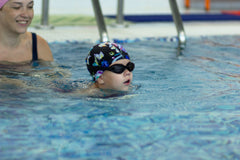
When your little mermaid or merman wants to get into the pool, we know how precious they are. It's important to you and to us to safeguard your little ones while they enjoy their play. Pools are such great fun for kids, but they can be dangerous as well.
In the case of beating the heat, there's no better way to do than a refreshing and crisp pool. But parents know extra caution should be used. Here are some of the top toddler swimming safety tips to keep your merkid safe.
Start swimming lessons early.
Start your toddler early with swimming lessons. The AAP (American Academy of Pediatrics) states that there is substantial evidence showing that giving kids swim lessons as early as age 1 can be far less likely to drown than children who do not. The earlier in the water, the more quickly they become comfortable.
If your toddler's new to the pool, always start with mom and dad so they feel safe and start with very small steps.
Always be present.
Always have an adult on-hand or around to watch and supervise any children in pools, bodies of water, bathtubs and even things like toilets and buckets. This seems like an obvious tip for some, but if you are a stay-at-home parent or a single parent, life can get pretty hectic with everyday tasks and a toddler and it doesn't take much to look away for one second.
Make time out of your schedule to be present at the pool, bathtub or any body of water distraction-free.
If at a beach or public pool, always swim where and when a lifeguard is present.
Always swim with your toddler.
The best way to keep eyes on your toddler in a large body of water, or pool small or great is always to swim with them at arms-length.
Have a fence.
Above-ground, in-ground, inflatable, portable, spas and natural bodies of water like lakes, ponds, canals, and rivers should have a barrier between the toddler and the water. Pools should be surrounded by a four-sided fence with a lock at least four feet high. If there's no fence, keep your merkids away and out of the water when they cannot be watched.
Lastly and most importantly is understanding and learning the signs of drowning. What we're shown in media, television, and movies is that drowning comes with loud coughing, shouting, sputtering, and big arm movements. Unfortunately, drowning is surprisingly fast and silent.
These tips should have you well on your way of enjoying a safe, happy swim with your little merfolk anytime, every time.


No Comments Yet. Would You Like to Leave One?